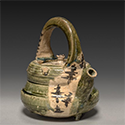|
|
| Show All 22 Results (Text Only) |
|
|
| Asian Odyssey: A National K-12 Interdisciplinary Curriculum Model |
|
|
The three-year project, "Asian Odyssey," produced this series of lesson plans to "advance the study of Asian Art and culture in K-12 curriculum by creating a model curriculum and program that is accessible to a national and international audiences via distance learning and the museum's web site." Resources are organized by grade level, include links to associate art objects, and cover the following subject areas: 1) Buddhism; 2) Daily Life & Festivals; 3) Daoism & Confucianism; 4) Geography & Climate; 5) History & Culture; 6) Literature & Folk Tales; 7) Science & Natural History; 8) Shinto; 9) Visual and Theatrical Art.
Go to Museum Resource: http://www.clevelandart.org/search?search=Asian+Odyssey | |
|
|
| Buddhist Art from China and Japan |
|
|
This lesson explores new objectives for art and examines how Chinese painting reflects Buddhist principles. Students learn to consider the meaning and significance of Buddhist mudras through the examination of images from the Cleveland Museum of Art.
Go to Museum Resource: http://www.clevelandart.org/lesson-plan-packet/buddhist-art-china-and-japan | |
|
|
| Chado: The Japanese Tea Ceremony |
|
|
This lesson introduces students to the Japanese tea ceremony to consider the art and the tradition of the tea ceremony and study the serving pieces used in the ceremony by participating in a tea ceremony. Students will learn the importance of the performance of tea ceremony through the history of how it became what it is today.
Go to Museum Resource: http://www.clevelandart.org/lesson-plan-packet/chado-japanese-tea-ceremony | |
|
|
|
| Confucius, Shotoku, and the Golden Rule |
|
|
Confucian thought, Prince Shotoku’s Constitution, and the Golden Rule provide an opportunity for teachers and students to develop a shared vision for learning and classroom relationships. By looking at these ancient sayings, modern-day students can formulate their own rules of conduct.
Go to Museum Resource: http://www.clevelandart.org/lesson-plan-packet/confucius-shotoku-and-golden-rule | |
|
|
|
| Daoist Immortals |
|
|
This lesson plan uses art to introduce Daoism. This complex faith system, which can be regarded as polytheistic religion, has numerous religious figures, called Immortals. While this lesson focuses on the immortals, it also explores the complexity of the Daoist faith.
Go to Museum Resource: http://www.clevelandart.org/lesson-plan-packet/daoist-immortals | |
|
|
|
| Show All 22 Results (Text Only) |








